June 5th, 2025
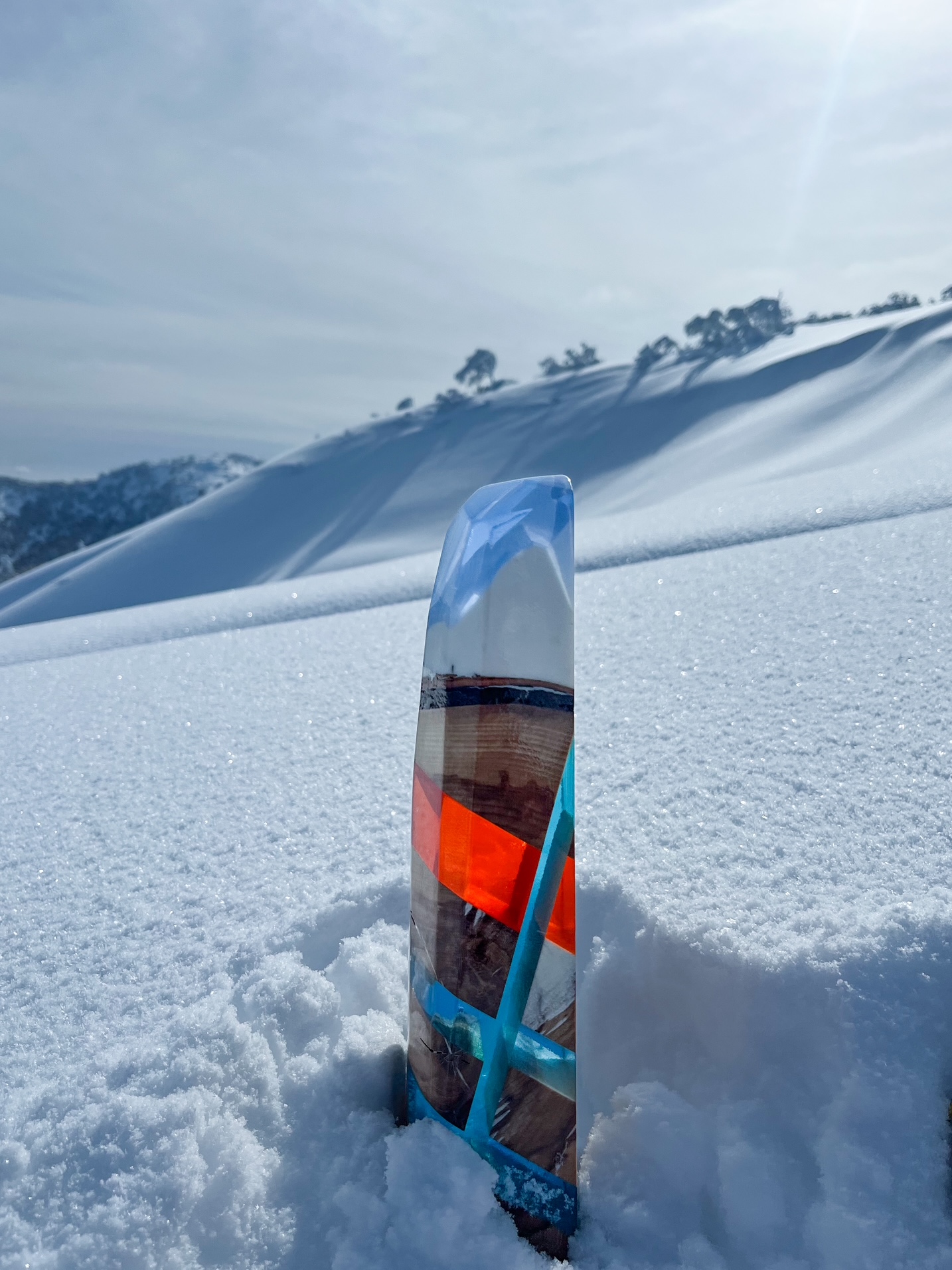
A sculpture by R. Nelson Parrish standing tall in the powdery snow of Japan. Photo by R. Nelson Parrish
Travel, in its most profound form, is not just a movement through geography but a shift in perception—a reorientation of the senses, the spirit, and the artist’s gaze. For Santa Barbara-based artist R. Nelson Parrish, a recent two-week expedition into the snow-draped backcountry of Hokkaido, Japan became precisely that: a pilgrimage of light, texture, and introspection. Parrish’s journey, rooted in intention and spontaneity, blended Zen ritual, crystalline powder, and ephemeral landscapes into a single immersive experience that is now beginning to echo through his evolving practice.
This blog marks the beginning of a new Gallery MAR series exploring the travels that shape our artists’ work—the landscapes that challenge them, the cultures that sharpen their vision, and the serendipitous moments that alter their creative trajectory. As Parrish reflects on the shifting weather of Hokkaido, the quiet divinity of Ebisu Rock, and the translucent sculptures he carried through the hills like talismans, we witness the quiet alchemy of place becoming practice. His art, already kinetic and contemplative, now hums with a new reverence for imbalance, impermanence, and presence—the very essence of the journey itself.
Gallery MAR: You recently got back from a trip to Japan. Could you tell us a little more about your trip? When and for how long were you there?
Nelson Parrish: Yes, I recently visited the backcountry of Hokkaido – the north island of Japan – in late January/early February for two weeks. The goal was to accomplish several things – study the light and landscape, visit a couple of out of the way shrines, perform a traditional Misogi, and take a much-needed break from the studio and California. A great friend has lobbied me for almost a decade, and I need to go, so this was the year I pulled the trigger. It turned out to be THE year in terms of snow and weather, as luck would have it. Because of this, I was offered a last-minute assignment to take some lifestyle and action shots for Beringia—double luck.
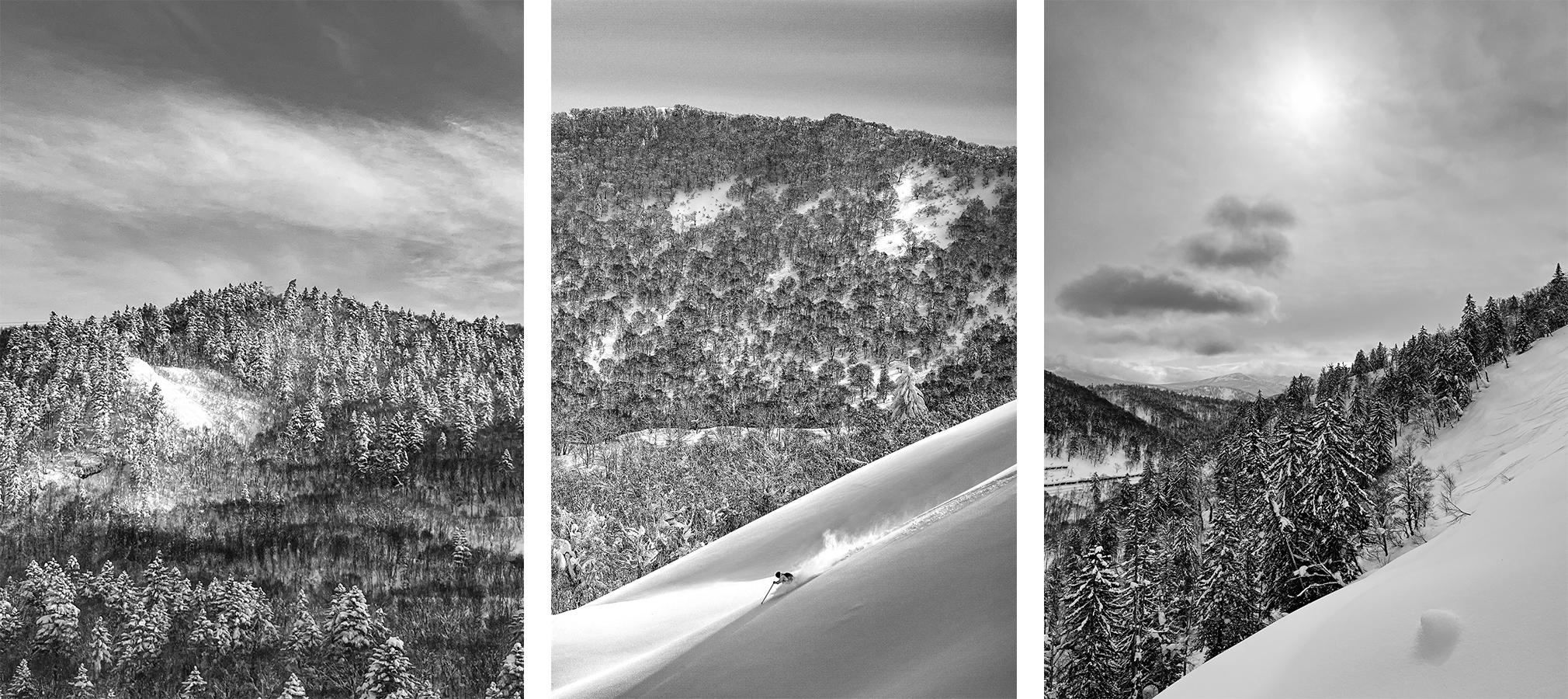
Black and White Photography from R. Nelson Parrish of his ski trip to Japan
Gallery MAR: What in particular did you love about Japan? What were you most inspired by, both personally and artistically?
Nelson Parrish: What to love about Japan? What is there not to love? The people are so unbelievably friendly, the food is delicious, and everything is immaculate. I wouldn’t hesitate to walk barefoot into a truck stop bathroom. And the Onsens! I thought Finnish sauna culture was decadent, but Japanese bathhouses are divine. I’ve never felt so clean, especially after sweating buckets daily skinning around in the hills.
The most striking thing was the landscape itself. There is a subtly to its grandeur. My initial response was that of familiarity – honestly, Hokkaido, at first glance, looks very familiar to the interior of Alaska. Similar rolling hills, blue tones, and what most would say, “a whole lotta nothing.” But when you looked closer, there were vast differences – the space between the trees, how the light gently rolled into shadow – very subtle contrast, and colors were highly nuanced. Even the water was a different type of clear, making the snowflakes more crystalized. It makes so much sense why Japanese watercolors and inkwork look ethereal. The art directly represents the landscape, not a highly stylized interpretation.
A more striking aspect of the landscape was the weather. You could experience 4 or 5 different weather patterns in 20 or 30 minutes: light snow, bright sun, storm flurries, thick overcast, and cloudless sky. Same with the snow itself. Hike 500 ft in any direction, and it is simply different. Because of this constant state of change, it emphasized the necessity to be present with yourself and your surroundings as the next step; the next minute could be vastly different.
These observations resulted in the overpowering sentiment that Zen philosophy could only come from a place such as this: where the empty space between two objects was an object in itself, and each moment in life was a gift.
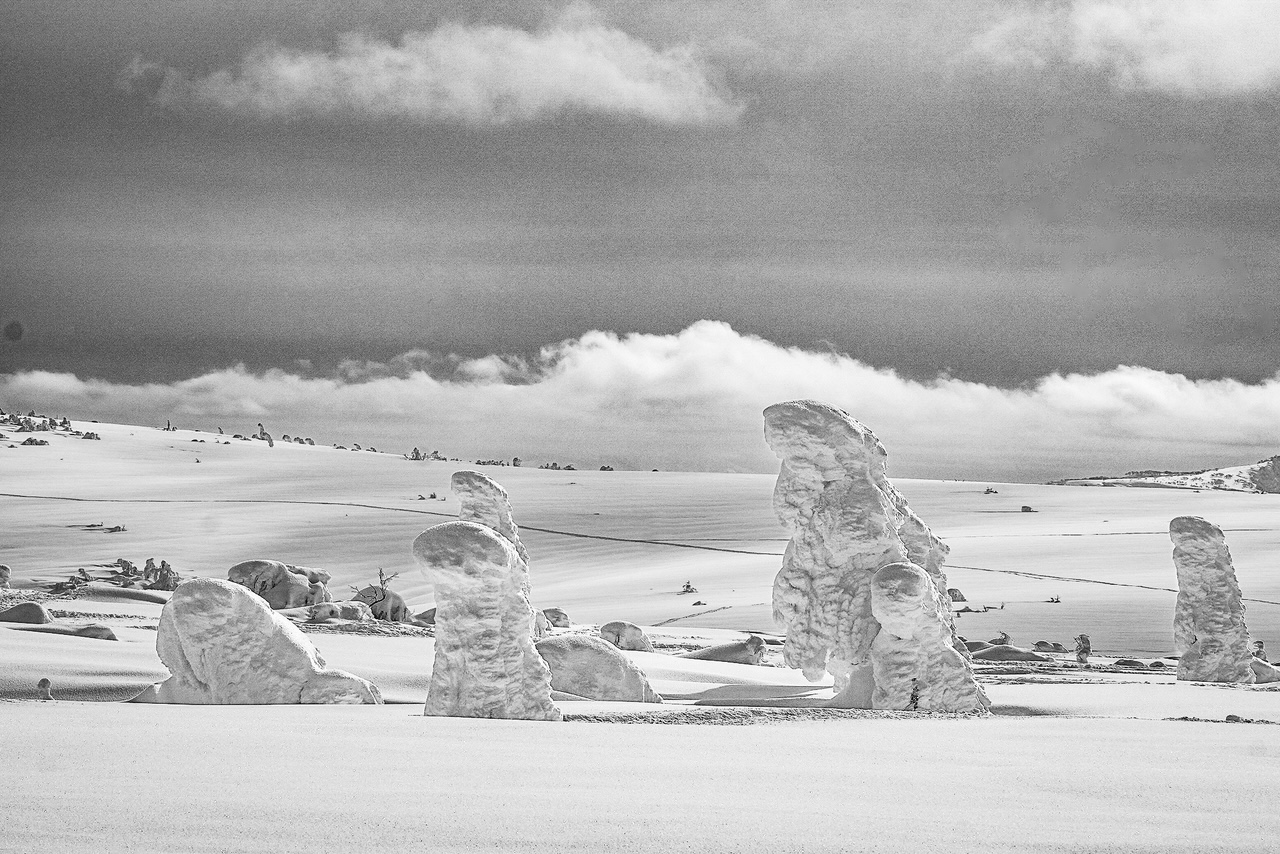
A snowy landscape from R. Nelson Parrish’s trip to Japan
Gallery MAR: I know many of your flitches have been influenced by travel and the experiences you have in far off places (for instance, the stones beneath the works taken from places that the work is inspired by). Do you believe this travel experience will have an influence on your work?
Nelson Parrish: As a side quest, I did get to swim around in the Sea of Japan. It was the closest thing to a traditional Misogi I could find. One of these guys randomly found this geological formation called Ebisu Rock – essentially a lava rock hoodoo about 50 meters off the coast. It turned out it was a mid-tier national treasure. I got to be alone with it, swimming around for fifteen or twenty minutes. The water was in the low 40s – similar to a cold plunge pool – and it was a unique electric blue when the sun hit it just right.
Ebisu Rock itself was in the shape of a bulbous ice cream cone. It stands roughly 65 feet tall and about 15 feet wide across the top. But the bottom couldn’t be more than a couple of feet wide, caused by the slow erosion of the sea, giving it a very precarious stance – as if it would topple at any minute. But Ebisu Rock has been that way for centuries, making it all the more spectacular.
There is a core zen concept, fukinsei, which champions the notion of balanced asymmetry, irregularity, and the beauty of controlled imbalance. Most use the term when applying aesthetic concepts to natural objects, which are perfectly “imperfect.” Ebisu Rock is a stunning example of this concept; I was lucky to experience it. Throughout the entire trip, fukinsei conceptually rolled around in my head. I’ve been able to retranslate it for myself as the harmony of imbalance, which I feel holds a lot of resonance today on both the micro and macro levels. Lately, I’ve been answering the phone as “Chaos Incorporated,” which seems very fitting. I’ve always played around with this idea in my work in a subtle way, but I feel I’ll be bringing it more to the forefront in upcoming works.
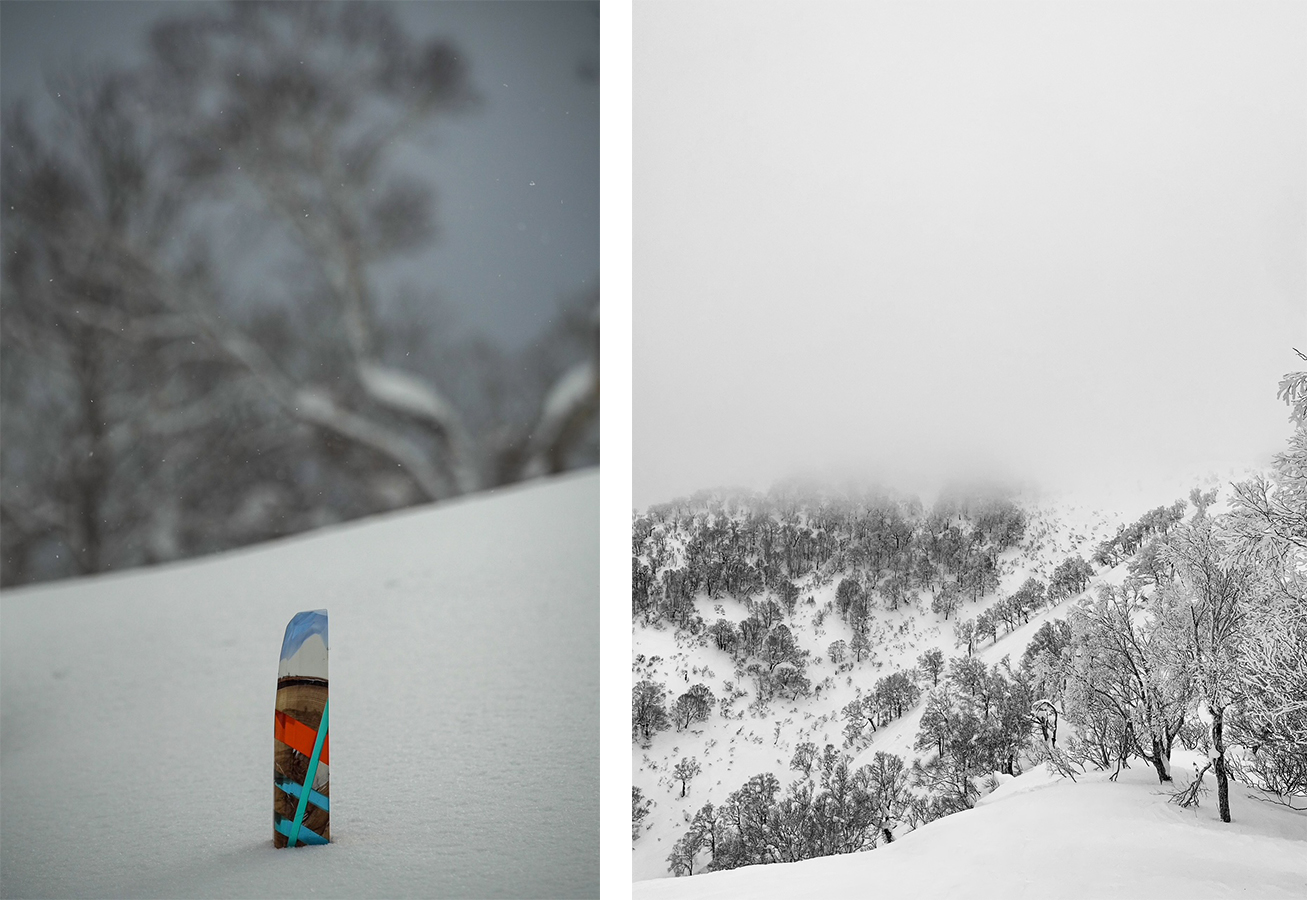
R. Nelson Parrish’s bioresin sculpture, “Not All Mountains Are Made of Stone” in the snow in Japan
Gallery MAR: It looks like many of your bioresin pieces are even more translucent than usual, as highlighted in the stunning landscape settings that you’ve photographed them in. Could you talk a little about the inspiration behind this and the direction you see your work taking?
Nelson Parrish: A few years ago, I made a small piece – a prism roughly the size of my fist – that I began traveling with. Titled “Tiny Universe,” it comprises an opaque navy blue with a thin shock of translucent orange right square down the middle. Its initial intention was so I could color correct my photographs. Blue and orange are on opposite sides of the Newtonian and Munsell Color Wheel, so for me, Tiny Universe was the color equivalent to the grey card for black and white photography. It was the constant to my ever-changing locations and became an anchor for colors I wanted to remember back in the studio.
But then the piece evolved, taking on a narrative of its own. Like an abstract traveling gnome, I started putting it in precarious places or using it to initiate conversations with strangers with whom I wanted to take their portrait. Photography is still a big part of my art practice; having a simple prop always eases tension. People immediately forget the lens and drop their guard. You get a much more authentic and candid representation of the person.
So for Japan, I made a column, roughly a foot and a half tall – white, blue, and orange – and carried it with me every day in the backcountry. And inadvertently, possibly the best photo of the entire trip was of that piece, “Not All Mountains are Made of Stone,” sunk into snow atop an unmarked ridge with the Sea of Japan on the horizon. That image has resounded, driving my desire to do more. The image deepens the piece’s understanding, and I plan to create similar accessible experiences. I plan to invite small audiences to see the work temporarily installed in the awe-compelling landscapes, creating impactful and enriching moments outside of the gallery setting. Art is not limited to objects.
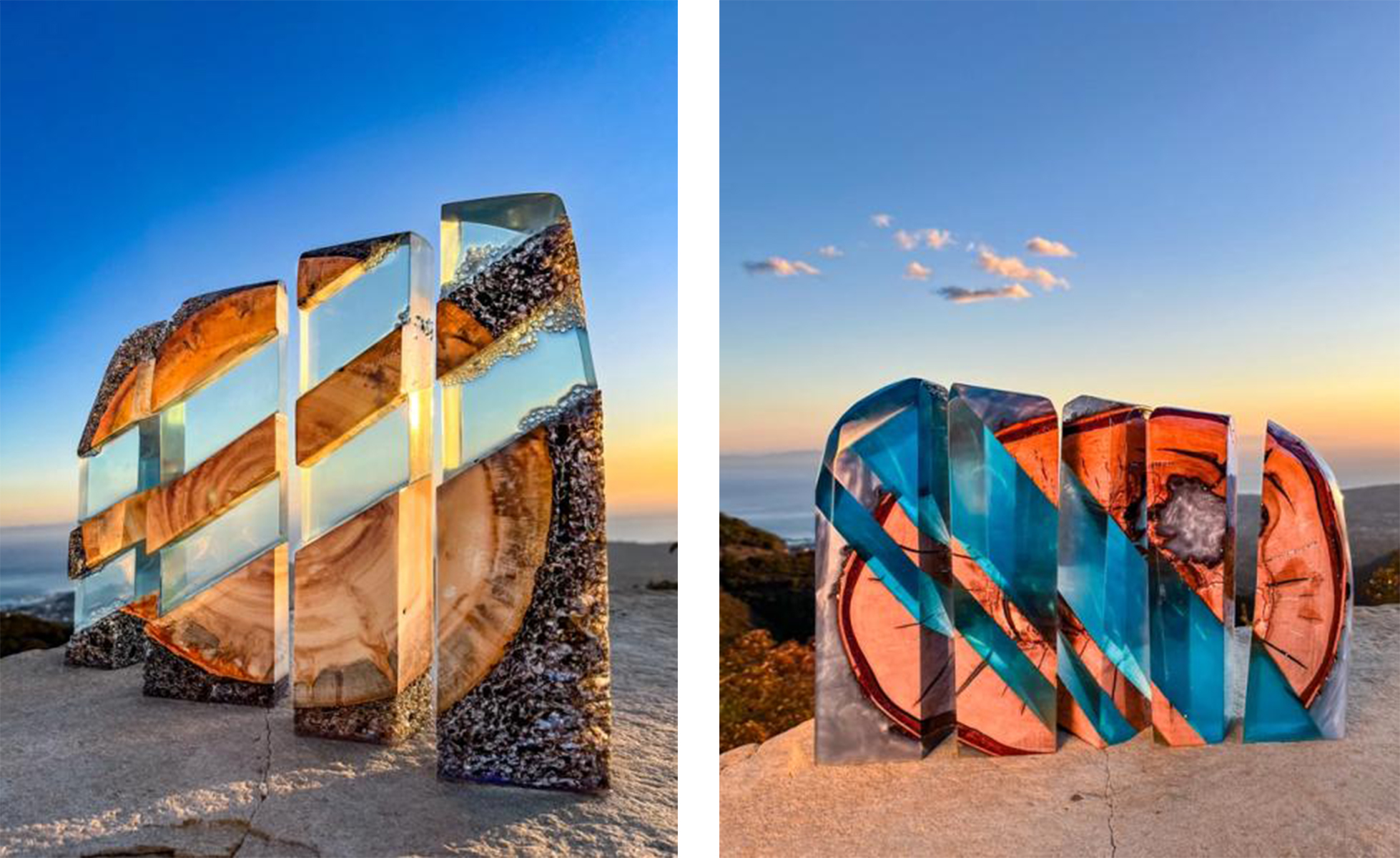
R. Nelson Parrish sculpture at Gallery MAR: “Summit,” bioresin and wood, 12″ x 11″ x 4″ | “Grotto,” bioresin and wood, 12″ x 11″ x 4″
Gallery MAR: Is there anything new that you would like for our collectors to know or anything that you think they might be interested to learn of your work and life of late?
Nelson Parrish: Moving forward, I’ll be broadening the perception of my art practice. I’ve always considered myself more of a conceptually driven fine artist, but I have been typecast as a sculptor for the last few years. I find this very limiting; regardless of my first decade of practice as a fine art photographer, I’ve sold over 100 paintings and completed several public installations and murals. I never want to limit myself to form, medium, or materials. My goal as an artist is not to make physical things but to create invitations of inspiration – a metaphorical doorway, a portal, a ticket…to escape, explore, and expand. My art is a, “Hey, let’s go for a ride. I’ll drive, you navigate.” Art is a vehicle to dream, remember, contemplate, feel, and get excited. It is all those things and all things I cannot put into words.
With summer coming up and the weather getting too hot to pour resin in the studio, I will be focusing a lot on non-sculpture and experimentation. Push some boundaries and evolve deeper. I’ve even begun a rough draft of a small poetry collection that I’d like to publish before the year ends. If Japan taught me anything, it is that the future is now, the present is a gift, and stepping away provides space for the unexplored. And right now, all of this sounds pretty good to me.
Gallery MAR: Wow, thank you for your insights and for sharing stories of your travel. We here at Gallery MAR are thrilled to see what new artwork is born of these profound experiences.
Find the latest work from R. Nelson Parrish here at Gallery MAR.
Written and interviewed by Veronica Vale
 The View Through the Window: A Conversation with Bridgette Meinhold
The View Through the Window: A Conversation with Bridgette Meinhold Happy Howl-o-ween!
Happy Howl-o-ween! Nina Tichava at the AMoA Biennial
Nina Tichava at the AMoA Biennial